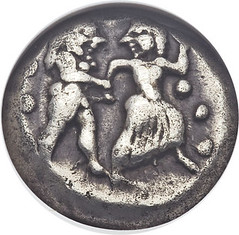
PREV ARTICLE
NEXT ARTICLE
FULL ISSUE
PREV FULL ISSUE
THE SATYR AND THE NYMPH STATER
The April 6, 2015 issue of The Classical Coin Newsletter (an email publication of Heritage Auctions) highlights an unusual coin
design - the "Satyrical" scene from Siris. -Editor
 
The ancient Greeks in the "civilized" southern portion of the peninsula regarded the people of the northern hinterlands, Macedon and Thrace in particular, as a wild, unrestrained bunch incapable of rational thought, entirely ruled by their lust for drinking, warfare and, of course, their rampant sexuality. Dionysus, the Olympian god of wine and drinking, is said to have hailed from these northern parts and his sacred rites, later called "Bacchanalia" (after his Roman counterpart Bacchus), were famously ribald. As if to confirm the Greek view of their nature, the early coins struck by Thraco-Macedonian cities and tribes often feature ithyphallic (that is, sexually excited) satyrs chasing around, or carrying off, nubile young maidens, usually called "nymphs." Satyrs, the often-drunk and always erect companions of Dionysus, are depicted as nude, muscular men with pointed ears and a tail; the nymphs usually wear a flowing, diaphanous dress called a chiton. On the silver staters of the island city of Thasos, circa 520-450 BC, the satyr is actually carrying the nymph, who raises her hand in a gesture usually interpreted as a protest. It has been suggested that the Thasos coins actually depict a special dance that is part of Dionysic ritual (Dionysus was prominently worshipped in northern Greece and his portrait appears on later coins of Thasos). Silver staters struck at the mint recently identified as Siris in Macedon, including this rare variety, depict a somewhat different scene — the nymph is fleeing the satyr, who reaches out to grasp her arm. Our coin, rendered with the full, rough vigor of the archaic Greek style, has an added feature not seen on other varieties: The nymph appears to grasp the Satyr's erect male member and looks back into his face with an expression that seems to say "gotcha!" It would appear to be a rare instance of the female "prey" getting the upper hand, so to speak, on her male pursuer. The Siris ('Lete'). Ca. 525-480 BC. AR stater is being offered as part of our April 9 - 14 CICF World Coins & Ancient Coins Signature Auction. For more information and/or to be put on the list to receive a copy of the catalog, contact David S. Michaels (DMichaels@HA.com) or Sam Spiegel (SamS@HA.com). To read the complete article, see:
To read the auction lot description, see:
Wayne Homren, Editor The Numismatic Bibliomania Society is a non-profit organization promoting numismatic literature. See our web site at coinbooks.org. To submit items for publication in The E-Sylum, write to the Editor at this address: whomren@gmail.com To subscribe go to: https://my.binhost.com/lists/listinfo/esylum All Rights Reserved. NBS Home Page Contact the NBS webmaster 
|